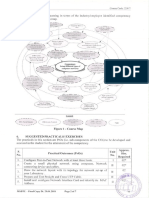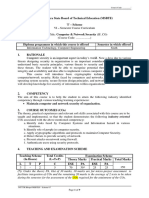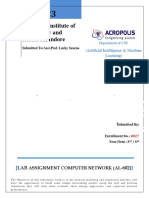0 ratings0% found this document useful (0 votes) 331 views8 pagesAdvanced Computer Network
Copyright
© © All Rights Reserved
We take content rights seriously. If you suspect this is your content,
claim it here.
Available Formats
Download as PDF or read online on Scribd
Advanced Computer Network Course Code: 22520
ProgramName —: Computer Engineering Program Group / Diploma in Cloud
Computing and Big Data / Diploma in Computer Hardware &
Maintenance
Program Code CO/CM/IF/CW/BD/HA
Semester : Fifth
Course Title : Advanced Computer Network (Ele
Course Code 122520
1. RATIONALE
‘The modem computer network includes different routing protocols and applying the concepts
of network, transport and application layer protocols. In order to work with existing
technology in building large, complex networked systems, students must be acquainted with
the principles, architectures, and protocols used in moder networked systems. This course
covers advanced computer network protocols, and advanced principles of the design of
computer networks. After completing this course students will be able to configure various
TCPIIP protocols at different layers.
2. COMPETENCY
The aim of this course is to help the student to attain the following industry identified
competency through various teaching learning experiences:
* Configure network protocols at different layers of TCP/IP protocol set.
3. COURSE OUTCOMES (COs)
The theory, pructical experiences and relevant soft skills associated with this course are to be
taught and implemented, so that the student demonstrates the following industry oriented
COs associated with the above mentioned competency:
a) Implement Network Layer Protocols.
b) Configure IPvé Network.
©) Choose routing protocol in the given network situation.
4) Implement different Transport Layer Protocols.
©) Configure various Application Layer Protocols.
4, TEACHING AND EXAMINATION SCHEME
Teaching 7
aa Examination Scheme
Credit Theory Practical
L| ar] p (orm) ESE PA Tol) ESE
Paper total PA. Total
Hrs. [Max [Min | Max [Min| Max | Min] Max | Min | Max | Min | Max | Min
3[-[2][ 5 [3 | [28 [30 [oo | 100 | 40 | 2s# [ 10 | 25 | 10 | 50 | 20
(4): Under the theory PA; Out of 30 marks, 10 marks of theory PA are for micro-project
assessment (0 facilitate integration of COs and the remaining 20 marks is the average of 2
tests to be taken during the semester for the assessment of the UOs required_for_the
attainment of the COs. qo.orT
Legends: L-Lecture; T — Tutorial/Teacher Guided Theory Practice; P - Pra
ESE - End Semester Examination; PA - Progressive Assessment,
MSBTE — Final Copy Dt. 11.07.2023 Page 1 of 8�Adeanced Computer Newark Course Code: 22820
5. COURSE MAP (with sample COs, PrOs, UOs, ADOs and topics)
This course map illustrates an overview of the flow and linkages of the topics at various levels
of outcomes (details in subsequent sections) to be attained by the student by the end of the
course, in all domains of learning in terms of the industry/employer identified competency
depicted at the centre of this map.
7 ieorics ~ -
—
A SER -
Figure I - Course Map
6. SUGGESTED PRACTICALS/ EXERCISES
The practicals in this section are PrOs (i.e. sub-components of the COs) to be developed and
assessed in the student for the attainment of the competency.
s. Approx.
7 Practical Outcomes (PrOs) Unit No. Hrs.
No. ;
Required
1. _| Given an IP address, network mask, and subnetwork mask, I 2
determine other information and implement it.
about the IP address such as:
‘The subnet address of this subnet.
ii. The broadcast address of this subnet.
iii, The range of host addresses for this subnet.
iv. The maximum number of subnets for this subnet
‘MSBTE — Final Copy Dt. 11.07.2023 Page 2 of 8�Advanced Compute Network Course Code: 22590
a “Approx.
No. Practical Outcomes (PrOs) Unit No. Hrs.
Required
mask, |
v. The number of hosts for each subnet.
vi, The number of subnet bits.
vii, The number of this subnet.
2. a. Capture ICMPv4 packets generated by utility programs i 2
like ping, traceroute and tabulate all the captured
parameters using relevant software
b. Investigate IP Protocol by capturing IP datagrams and
tabulate all the captured parameters using relevant software
Configure IPv6 network using any network simulator. 2
Configure IP static routing using relevant software. fii 02
._| Configure IP routing with RIP using relevant software. UL 02"
6.___| Configure IP routing with OSPF using relevant software UL 02*
7. Configure User Datagram Protacal (INP) Pari-T using Iv 02*
relevant software.
8. | Configure User Datagram Protocol (UDP) Part-l using iy 2
relevant software.
9. | Configure Transmission Control Protocol (TCP) using Vv OF
relevant software.
10._| Run different STCP commands, 1V @
11. | Configure Dynamic Host Configuration Protocol (DHCP) v (2
using relevant software,
12. | Configure Domain Name Server (DNS) using relevant Vv om
software,
13. | a. Configure File Transfer Protocol (FTP) using relevant V 02
software.
b. Configure Hypertext Transfer Protocol (HTTP) using
relevant software.
14, | a. Use Telnet to login a remote machine. Vv 02*
b. Connect remote machine using Secure Shell (SSH).
15._| Configure SMTP, POP3 and IMAP using relevant software. Vv 02*
16. | Configure MIME and SNMP using relevant software. v 02
Total 32
Note
iA suggestive list of PrOs is given in the above table. More such PrOs can be added to
attain the COs and competency. A judicial mix of minimum 12 or more practicals need to
be performed, out of which, the practicals marked as ‘*’ are compulsory, so that the
student reaches the ‘Application Level’ of Bloom's Taxonomy’ as generally required by the
industry.
ii, The ‘Process’ and ‘Product’ related skills associated with each PrO are to be assessed
according to a suggested sample given below:
S.No. Performance Indicators Weightagein % 7p
L. Completion of given task. rr
2. | Correctness of the given task. :
MSBTE — Final Copy Dt. 11.07.2023 Page 3 of 8�Advanced Computer Network Course Code: 22500,
3 ‘Answer to sample questions. 15
4 ‘Submit report in time. 10
Total 100
The above PrOs also comprise of the following social skills/attitudes which are Affective
Domain Outcomes (ADOs) that are best developed through the laboratory/field based
experiences:
Follow safety practices.
Practice good housekeeping.
Work as a leader/a team member.
Follow standard configuration procedures.
Follow ethical practices.
epegse
The ADOs are not specific to any one PrO, but are embedded in many PrOs. Hence, the
acquisition of the ADOs takes place gradually in the student when s/he undertakes a series of
practical experiences over a period of time. Moreover, the level of achievement of the ADOs
according to Krathwohl’s ‘Affective Domain Taxonomy’ should gradually increase as
planned below:
© ‘Valuing Level’ in 1St year
‘© ‘Organising Level’ in 2"4 year and
© ‘Characterising Level’ in 34 year.
7, MAJOR EQUIPMENT/ INSTRUMENTS REQUIRED
The major equipment with broad specification mentioned here will usher in uniformity in
conduct of experiments, as well as aid to procure equipment by authorities concerned,
‘S.No. Equipment Name with Broad Specifications PrO S.No.
1 | Computer system All
(Any computer system with basic configuration, connected to LAN)
2 | Wireshark or any other similar software to capture and investigate 12
packets
3_| Cisco Packet Tracer or any other similar software 31016
8. UNDERPINNING THEORY COMPONENTS
The following topics are to be taught and assessed in order to develop the sample UOs given
below for achieving the COs to attain the identified competency. More UOs could be added.
Unit Unit Outcomes (WOs) Topics and Sub-topies
(in cognitive domain)
Unit—1 la. Explain significance of the given | 1.1 IP Addressing: Address Space,
Network field in the packet format of Notations, Classfull addressing,
Layer and | Internet Protocol. Classless addressing, Network
Protocols | 1b. Implement IP addressing for the ‘Address Translation (NAT).
given network.
1c. Explain significance of the given
field in packet format of
ICMP v4. Tools, ICMP Checksum
1d. Explain the given inefficiency in | 1.4 Mobile IP: Addressi
Mobile IP. Three Phases, Ineffi
1.2 Internet Protocol (IP): Datagram.
Format, Fragmentation, Options.
1.3 ICMPv4: Messages, Debugging
MSBTE — Final Copy Dt. 11.07.2023,
Page 4 of 8�Advanced Computer Network
Course Coe: 2520,
Unit Unit Outcomes (UOs) Topics and Sub-topics
(in cognitive domain)
Mobile IP.
1.5 Virtual Private Network: VPN.
I Technology
Unit-11 | 2a. Map the given IPv4 address to | 2.1 IPV6 Addressing: Representation,
Next IPV6 address. address space, address space
Generation | 2b. Describe function of the given allocation, Autoconfiguration,
IP step in the stateless auto Renumbering.
configuration process. 2.2 Transition from IPv4 to IPv6:
2c. Outline the given strategy of Dual Stack, Tunneling, Header
Transition from IPv4 to IPv6. Translation.
2d, Explain significance of the given | 2.3 IPV6 Protocol: Packet format,
field in Datagram format of IPv6.| Extension Header.
Unit III | 3a. Choose relevant routing Protocol | 3.1 Introduction: Inter-domain, Intra
Unicast for the given network situation. domain Routing.
and 3b. Compare Dynamic Routing and | 3.2 Routing Algorithms: Distance
Multicast Static Routing on the given Vector Routing, Bellman-Ford
Routing aspect. algorithm, Link State Routing,
Protocols | 3c. Calculate shortest paths from a Path Vector Routing.
single source vertex to all the —_| 3.3 Unicast Routing Protocols:
other vertices in the given Internet Structure, Routing
weighted digraph. Information Protocol (RIP), Open
3d. Explain functioning of the given Shortest Path First (OSPF), Border
multicast routing protocol. Gateway Protocol Version 4
(BGP4).
3.4 Introduetion: Unicast, Multicast
and Broadcast.
3.5 Intradomain Multicast
Protocols: Multicast Distance
Vector (DVMRP), Multicast Link
State (MOSPF), Protocol
Independent Multicast (PIM),
UnitIV | 4a. Explain significance of the given | 4.1 User Datagram Protocol: User
Transport | field in UDP Packet format. Datagram, UDP Services, UDP
Layer 4b. Describe the given State Applications.
Protocols Transition of TCP. 4.2 Transmission Control Protocol:
4c. Explain significance of the given TCP Services, TCP features,
field in TCP Packet format. Segment, A TCP Connection,
4d, Describe the given field in the State Transition Diagram,
packet format of SCTP. Windows in TCP, Flow Control,
4e. Explain the functioning of the
given Protocol with Flow and
Error control by taking an
example.
Error Control, TCP Congestion
Control, TCP Timers, Options.
43 SCTP: SCTP Services, SCTP
Features, Packet Format, An SCTP
Association, Flow Captbhi
Control. se
MSBTE ~ Final Copy Dt. 11.07.2023
Page 5 of 8�Advanced Computer Nerwork
Course Code: 22520,
Unit Unit Outcomes (UOs) Topics and Sub-topics ]
(in cognitive domain)
Unit-V | SaExplain function of the given | 5.1 World Wide Web and HTTP |
Application | application layer protocol. 5.2 File Transfer: FTP and TTP |
Layer 5b.Explain function of the given 5.3. Electronic Mail: Architecture,
protocols FTP command. Web-Based Mail, Email Security,
Se. Explain working of the given
components in the Architecture
of Electronic Mail.
5d. Explain process of resolving the
given host name into IP address
using DNS.
SMTP, POP, IMAP and MIME,
SNMP.
DNS — Concept of Domain name
space, DNS operation.
DHCP ~ Static and Dynamic
Allocation, DHCP Operation.
Se. Explain working of the given 5.6 Remote Login: TELNET and SSH.
Remote Login Protocol.
_|_
‘Note: To attain the COs and competency, above listed UOs need to be undertaken to achieve
the ‘Application Level’ of Bloom's ‘Cognitive Domain Taxonomy’.
9, | SUGGESTED SPECIFICATION TABLE FOR QUESTION PAPER DESIGN
ji ; istribution of Theory Marks
bag Unit Title eae rar U | Aid| Total
Level_| Level | Level | Marks
T_| Network Layer and Protocols 06 o | 2 | o | 08
T_[ Next Generation IP 08 o | o4 | 04 | 10
TH | Unicast and Multicast Routing 10 oz | o¢ | 08 | 14
Protocols.
TV_| Transport Layer Protocols 2 a | o | o | i
V_| Application Layer Protocols. 12 04 [08 _|_08_| 20
Total 8 2 | 26 | 32 | 70
Legends: R=Remember, U-Understand, A=Apply and above (Bloom's Revised taxonomy)
Note: This specification table provides general guidelines to assist student for their learning
‘and to teachers to teach and assess students with respect to attainment of UOs. The actual
distribution of marks at different taxonomy levels (of R, U and A) in the question paper may
vary from above table.
10. | SUGGESTED STUDENT ACTIVITIES
Other than the classroom and laboratory learning, following are the suggested student-related
co-curricular activities which can be undertaken to accelerate the attainment of the various
‘outcomes in this course: Students should conduct following activities in group and prepare
reports of about 5 pages for each activity, also collect/record physical evidences for their
(student’s) portfolio which will be useful for their placement interviews:
a. Prepare journals based on practical performed in laboratory.
b. Give seminar on Identified topic.
c. Undertake micro-projects.
11. SUGGESTED SPECIAL INSTRUCTIONAL STRATEGIES (if any)
These are sample strategies, which the teacher can use to accelerate the attai
various learning outcomes in this course:
a, Massive open online courses (MOOCs) may be used to teach
MSBTE — Final Copy Dt. 11.07.2023
Page 6 of 8�Advanced Computer Network
topics
b. ‘L’ in item No. 4 does not mean only the traditional lecture method, but different
types of teaching methods and media that are to be employed to develop the outcome:
c. About 15-20% of the topics/sub-topies which is relatively simpler or descriptive in
nature is to be given to the students for self-directed learning and assess the
development of the COs through classroom presentations (see implementation
guideline for details).
With respect to item No.10, teachers need to ensure to create opportunities and
provisions for co-curricular activities.
Guide student(s) in undertaking micro-projects.
Demonstrate students thoroughly before they start doing the practice.
Encourage students to refer different websites to have deeper understanding of the
topic.
Observe continuously and monitor the performance of students in Lab.
=
Fo mme
12, SUGGESTED MICRO-PROJECTS
Only one micro-project is planned to be undertaken by a student that needs to be assigned to
hinv/her in the beginning of the semester. In the first four semesters, the micro-project are
group-based. However, in the fifth and sixth semesters, it should be preferably be individually
undertaken to build up the skill and confidence in every student to become problem solver so
that s/he contributes to the projects of the industry. In special situations where groups have to
Le formed for mieto-projects, the number of students in the group should of exceed three.
Tho micro project could be industry application basud, intuuct-based, wuikslop-
based, laboratory-based or field-based. Each micro-project should encompass two or more
COs which are in fact, an integration of PrOs, UOs and ADOs. Each student will have to
maintain dated work diary consisting of individual contribution in the project work and give a
seminar presentation of it before submission. The total duration of the micro-project should
not be less than 16 (sixteen) student engagement hours during the course. The student ought
to submit micro-project by the end of the semester to develop the industry oriented COs.
A suggestive list of micro-projects is given here, Similar micro-projects could be
added by the concemed faculty:
i, Prepare one Static and One dynamic Network with DHCP server. Use Routing Protocol to
route packets between these networks using Cisco packet tracer or any other similar
software.
ii, Setup a FTP server and client on one network. Transfer files from Client to server and vice
versa,
iii, (a) Create DNS,
(b) Create Web server,
(©) Serve an HTML page on web server and call it on browser through DNS.
iv, Set-up a mailing system of users on intranet.
13. | SUGGESTED LEARNING RESOURCE!
ER Title of Book Author Publication
1 | Data Communication and | Forouzan Behrouz _ | McGraw Hill Education (India),
Networking SE A New Delhi, 2005, ISBN-13:
25-906475-3 “ok
2 Internetworking with Comer Douglas E. | Prentice Hall of Iy@ePri
TCP/IP, Volume I, Limited, New
Fourth Edition. ISBN-81-203.
MSBTE — Final Copy Dt. 11.07.2023,�Advanced Computer Network ‘Course Code: 22520
3] Computer Networks, | Tanenbaum Andrew | PHI Learning, New Delhi- 2014
Fourth Edition s ISBN-81-203-2175-8
4 Advanced Computer B.M. Harwani and Dreamtech New Delhi- 2014
Network DT Editorial ISBN 978-93-5004-013-3
Services
3 | Computer Networks Natalia Olifer, Wiley
Principles, Technologies And | Victor Olifer ISBN
Protocols For Network Design
14. SOFTWARE/LEARNING WEBSITES
a) TCP/IP Illustrated, Volume 1 The Protocols W. Richard Stevens
b) http://study-ccna.com/
©) http://www-packettracernetwork.com/
4) _https:/Awww.tutorialspoint.comy/listtutorials/networking/1
©) www.txvotf.org/wp-content/uploads/2010/08/Muhummad-Tutorial-ipv6-basies.pdf
1) http://enp3book.info.ucl.ac.be/2nd/html/protocols/bgp. htm!
2) https://campus.barracuda.com/product/nextgentirewalli/doc/46209264/dynamic-
routing-protocols-ospf-rip-bep/
h)_http://Wwww.ciscopress.com/articles/article.asp?p=21802 1 0andseqNum=5
i) _http:/\www.allsyllabus.com/aj/note/Computer_Science/Computer%20Networks%20-
201
MSBTE — Final Copy Dt. 11.07.2023, Page 8 of 8





























































